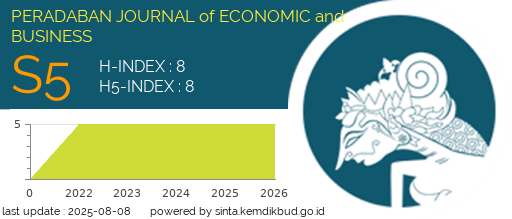Satu Dasa Warsa BRICS
Analisis Peluang dan Tantangan dalam Tinjauan Literatur Naratif
DOI:
https://doi.org/10.59001/pjeb.v4i1.278Keywords:
BRICS, economic growth, environment, human capital, sustainable development.Abstract
This narrative literature review examines the opportunities and challenges faced by BRICS (Brazil, Russia, India, China, and South Africa) over the past decade, focusing on Indonesia's potential integration into the alliance. The study highlights key areas such as green growth, renewable energy adoption, economic integration, and geopolitical dynamics. BRICS countries have shown varying progress in transitioning to cleaner energy sources, with Brazil and China leading in renewable energy investments, while Indonesia faces challenges in reducing fossil fuel dependency. The review also explores the role of human capital, financial development, and intellectual property rights in driving sustainable growth. Despite internal disparities and geopolitical tensions, BRICS strengthens its influence in global economic governance. Indonesia's participation in BRICS offers strategic economic and geopolitical advantages, including diversification of trade partnerships and technology transfer, but requires careful management of risks such as fossil fuel dependency and geopolitical competition. The study concludes that BRICS must address internal challenges, including corruption and institutional weaknesses, to fully realize its potential as a global economic force.
Tinjauan literatur naratif ini mengkaji peluang dan tantangan yang dihadapi oleh BRICS (Brasil, Rusia, India, China, dan Afrika Selatan) selama dekade terakhir, dengan fokus pada potensi integrasi Indonesia ke dalam aliansi tersebut. Studi ini menyoroti area-area kunci seperti pertumbuhan hijau, adopsi energi terbarukan, integrasi ekonomi, dan dinamika geopolitik. Negara-negara BRICS telah menunjukkan kemajuan yang bervariasi dalam transisi ke sumber energi yang lebih bersih, dengan Brasil dan China memimpin dalam investasi energi terbarukan, sementara Indonesia menghadapi tantangan dalam mengurangi ketergantungan pada bahan bakar fosil. Tinjauan ini juga mengeksplorasi peran modal manusia, pengembangan keuangan, dan hak kekayaan intelektual dalam mendorong pertumbuhan berkelanjutan. Meskipun terdapat disparitas internal dan ketegangan geopolitik, BRICS terus memperkuat pengaruhnya dalam tata kelola ekonomi global. Partisipasi Indonesia dalam BRICS menawarkan keuntungan ekonomi dan geopolitik strategis, termasuk diversifikasi kemitraan perdagangan dan transfer teknologi, tetapi memerlukan pengelolaan risiko yang cermat seperti ketergantungan pada bahan bakar fosil dan persaingan geopolitik. Studi ini menyimpulkan bahwa BRICS harus mengatasi tantangan internal, termasuk korupsi dan kelemahan institusional, untuk sepenuhnya mewujudkan potensinya sebagai kekuatan ekonomi global.
References
Abdenur, A. E. (2017). Can the BRICS cooperate in international security. International Organisations Research Journal, 12(3), 73-93.
Arapova, E. Y. (2019). The “BRICS Plus” as the first international platform connecting regional trade agreements. Asia-Pacific Social Science Review, 19(2), 4.
Aziz, N., Mihardjo, L. W., Sharif, A., & Jermsittiparsert, K. (2020). The role of tourism and renewable energy in testing the environmental Kuznets curve in the BRICS countries: fresh evidence from methods of moments quantile regression. Environmental Science and Pollution Research, 27, 39427-39441.
Batista Jr, P. N. (2021). The BRICS and the financing mechanisms they created. Anthem Press.
Bhat, M. A., Jamal, A., & Wani, F. (2024). The nexus between economic growth and conditional exchange rate volatility: evidence from emerging economies. Journal of Economic and Administrative Sciences.
Bratersky, M., & Kutyrev, G. (2019). BRICS and the evolving Russia-India-China security agenda. Strategic Analysis, 43(6), 597-619.
Callcut, R. A., & Branson, R. D. (2009). How to read a review paper. Respiratory Care, 54(10), 1379-1385.
Chen, C. (2004) Searching for intellectual turning points: Progressive knowledge domain visualization. PNAS, 101 (suppl_1), 5303-5310. 10.1073/pnas.0307513100 CiteSpace Original
Chen, C. (2006) CiteSpace II: Detecting and visualizing emerging trends and transient patterns in scientific literature. Journal of the American Society for Information Science and Technology, 57(3), 359-377.10.1002/asi.20317 CiteSpace II
Deych, T. (2018). BRICS regional policy in Africa. In BRICS and Global Governance (pp. 242-264). Routledge.
Fracalossi de Moraes, R. (2020). Whither security cooperation in the BRICS? Between the protection of norms and domestic politics dynamics. Global Policy, 11(4), 439-447.
Gerasimova, A., & Khasuntsev, I. (2011, September). Institutional characteristic features of innovation systems development of BRICS countries. In 2011 International Conference on Management Science & Engineering 18th Annual Conference Proceedings (pp. 973-977). IEEE.
Gómez, E. J. (2017). Geopolitics in health: confronting obesity, AIDS, and tuberculosis in the emerging BRICS economies. JHU Press.
Green, B. N., Johnson, C. D., & Adams, A. (2001). Writing narrative literature reviews for peer-reviewed journals: secrets of the trade. Journal of sports chiropractic and rehabilitation, 15(1), 5-19.
Hao, Y., Chen, P., & Li, X. (2022). Testing the environmental kuznets curve hypothesis: The dynamic impact of nuclear energy on environmental sustainability in the context of economic globalization. Energy Strategy Reviews, 44, 100970.
Hasan, M. B., Wieloch, J., Ali, M. S., Zikovic, S., & Uddin, G. S. (2023). A new answer to the old question of the environmental Kuznets Curve (EKC). Does it work for BRICS countries?. Resources policy, 87, 104332.
Hooijmaaijers, B. (2021). China, the BRICS, and the limitations of reshaping global economic governance. The Pacific Review, 34(1), 29-55.
Iqbal, B. A., & Rahman, M. (2023). BRICS and India in the light of Russia-Ukraine crisis: Emerging challenges and opportunities. JE Asia & Int'l L., 16, 159.
Jahanger, A., Awan, A., Anwar, A., & Adebayo, T. S. (2023, August). Greening the Brazil, Russia, India, China and South Africa (BRICS) economies: Assessing the impact of electricity consumption, natural resources, and renewable energy on environmental footprint. In Natural resources forum (Vol. 47, No. 3, pp. 484-503). Oxford, UK: Blackwell Publishing Ltd.
Jahanger, A., Hossain, M. R., Usman, M., & Onwe, J. C. (2023). Recent scenario and nexus between natural resource dependence, energy use and pollution cycles in BRICS region: does the mediating role of human capital exist?. Resources Policy, 81, 103382.
Kamin, K., & Langhammer, R. J. (2024). BRICS+: a Wake-Up Call for the G7?. Cuadernos Económicos de ICE, (107), 133-145.
Kamin, K., & Langhammer, R. J. (2024). From BRICS to BRICS+: Sheer More Members is not a Challenge to G7. The Economists’ Voice, 20(2), 259-265.
Khmelevskaya, N. (2018). BRICS’sustainable development dialog: framing contours to a common agenda through the intragroup trade. Int Organ Res J, 13(4), 74-95.
Khorbaladze, E. (2021). BRICS development strategy-priority areas of cooperation for gaining a foothold in a Multipolar World Order. BRICS Law Journal, 8(4), 4-30.
Kirton, J., & Larionova, M. (2022). The first fifteen years of the BRICS. International Organisations Research Journal, 17(2), 7-30.
Li, J. (2021). Development of BRICS cooperation mechanism in new geopolitical conditions. In Proceedings of Topical Issues in International Political Geography (pp. 303-312). Springer International Publishing.
Li, J., & Pogodin, S. (2020, September). BRICS Economic Cooperation Factors in Global Governance. In IOP Conference Series: Materials Science and Engineering (Vol. 940, No. 1, p. 012029). IOP Publishing.
Li, L. (2019). BRICS: A limited role in transforming the world. Strategic Analysis, 43(6), 499-508.
Luzina, T. V., Dudareva, E. A., Akhmetshin, E. M., Prodanova, N. A., Berdova, Y. S., & Emaletdinova, G. E. (2019). International legal format for trans regionalisation of trade and economic partnership within BRICS in global development. Space and Culture, India, 7(3), 76-85.
Luzina, T. V., Dudareva, E. A., Akhmetshin, E. M., Yankovskaya, V. V., Berdova, Y. S., & Emaletdinova, G. E. (2018). The international and legal framework for transregionalization of trade and economic cooperation of the BRICS countries. European Research Studies, 21, 166-176.
Manigandan, P., Alam, M. S., Alagirisamy, K., Pachiyappan, D., Murshed, M., & Mahmood, H. (2023). Realizing the Sustainable Development Goals through technological innovation: Juxtaposing the economic and environmental effects of financial development and energy use. Environmental Science and Pollution Research, 30(3), 8239-8256.
McSweeney, B. (2016). Hall, hofstede, huntington, trompenaars, GLOBE: Common foundations, common flaws. In Transculturalism and Business in the BRIC States (pp. 13-58). Routledge.
Monyae, D., & Ndzendze, B. (2021). Introduction: The Genealogies, Elements and Implications of a ‘BRICS Order’. The BRICS Order: Assertive or Complementing the West?, 1-34.
Moyo, C., Mishi, S., & Ncwadi, R. (2022). Human capital development, poverty and income inequality in the Eastern Cape province. Development Studies Research, 9(1), 36-47.
Naresh, G., Vasudevan, G., Mahalakshmi, S., & Thiyagarajan, S. (2018). Spillover effect of US dollar on the stock indices of BRICS. Research in International Business and Finance, 44, 359-368.
Nassani, A. A., Aldakhil, A. M., Abro, M. M. Q., & Zaman, K. (2017). Environmental Kuznets curve among BRICS countries: spot lightening finance, transport, energy and growth factors. Journal of Cleaner Production, 154, 474-487.
Nathaniel, S. P., Yalçiner, K., & Bekun, F. V. (2021). Assessing the environmental sustainability corridor: Linking natural resources, renewable energy, human capital, and ecological footprint in BRICS. Resources Policy, 70, 101924.
Nayyar, D. (2020). 3 BRICS, emerging markets. Handbook of BRICS and Emerging Economies, 93.
Ojo, T. A. (2022). Financial inclusion and women empowerment in BRICS countries: Perspectives on India and South Africa. In The Political Economy of Intra-BRICS Cooperation: Challenges and Prospects (pp. 175-203). Cham: Springer International Publishing.
Öniş, Z., & Yılmaz, Ş. (2016). Turkey and Russia in a shifting global order: cooperation, conflict and asymmetric interdependence in a turbulent region. Third World Quarterly, 37(1), 71-95.
Papa, M. (2014). BRICS’pursuit of multipolarity: Response in the United States. Fudan Journal of the Humanities and Social Sciences, 7, 363-380.
Pittman, E. (2023). Realist Synthesis: An Innovative Approach to Literature Review for Complex Management Phenomena. Advancing Methodologies of Conducting Literature Review in Management Domain, 137-159.
Saggioro Garcia, A., & Curty Pereira, R. (2023). Political economy of South–South relations: an analysis of BRICS’investment protection agreements in Latin America and the Caribbean. Third World Quarterly, 44(1), 57-75.
Saisse, R. D. L. G., & Lima, G. B. A. (2019). Similarity modeling with ideal solution for comparative analysis of projects in the context of the additional brics proposal. Brazilian Journal of Operations & Production Management, 16(4), 659-671.
Shelepov, A. (2018). BRICS engagement with international institutions for better governance. In BRICS and Global Governance (pp. 49-69). Routledge.
Skelly, M., Duong, A., Simunovic, N., & Ayeni, O. R. (2019). Type of Review and How to Get Started. Basic Methods Handbook for Clinical Orthopaedic Research: A Practical Guide and Case Based Research Approach, 323-327.
Theile, C. M., & Beall, A. L. (2024). Narrative Reviews of the Literature: An overview. Journal of Dental Hygiene, 98(1).
Tsaurai, K. (2023). Foreign Direct Investment-Growth Nexus in BRICS: How Relevant are the Absorption Capacities?. Scientific Annals of Economics and Business, 70(1), 41-55.
Tyler, M. C., & Thomas, M. (2014). 15. BRICS and mortar (s): Breaking or building the global system?. The Rise of the BRICS in the Global Political Economy: Changing Paradigms?, 253.
Vazquez, K. C. (2021). Brazil and BRICS multilateralism à la carte: from bilateralism to community interest. Global Policy, 12(4), 534-538.
Verma, R., & Papa, M. (2021). BRICS amidst India‐China rivalry. Global Policy, 12(4), 509-513.
Xiujun, X. (Ed.). (2020). The BRICS studies: Theories and issues. Routledge.
Zerihun, M., Breitenbach, M., & Njindan Iyke, B. (2020). A comparative analysis of currency volatility among BRICS countries. Journal of African Business, 21(1), 78-104.
Zoccal Gomes, G., & Esteves, P. (2018). The BRICS effect: Impacts of south–south cooperation in the social field of international development cooperation.





